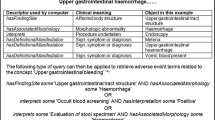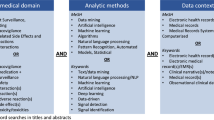Abstract
The introduction of MedDRA, the Medical Dictionary for Regulatory Activities, as a standardised terminology may have a major impact on the performance of risk management. Thus, MedDRA is likely to have an important effect on the analysis of clinical trial safety data. Review of the most commonly used terms in clinical trial tables from the labelling of ten products indicated that each adverse event could be represented by many MedDRA preferred terms; this might theoretically lead to failure to identify differences in adverse event incidence between treatment arms. Possible solutions are proposed. The use of MedDRA in spontaneous reporting systems is a regulatory requirement in some countries. Variability in modes of implementation and use of the terminology are discussed; these may impose additional limitations on any use of spontaneous data for comparative purposes. There are important differences in the ways that safety databases interface with MedDRA and uncertainty about the most appropriate way to manage version changes. The characteristics of MedDRA must be taken into account when establishing methods for signal detection and its use will affect the retrieval of similar cases as required for signal evaluation. The use of MedDRA in the periodic safety update report is discussed. The possible use of MedDRA in pharmacoepidemiology is highly relevant to risk management, and some issues are briefly outlined. With regard to communication of risk, if MedDRA is introduced into existing product labelling, care must be taken that the change itself does not cause misunderstanding; the most appropriate use of MedDRA in this regard remains to be determined. There is a need for careful evaluation of MedDRA in fulfilling its various functions in pharmacovigilance, followed by definitive regulatory guidance on its use.




Similar content being viewed by others
Notes
MedDRA is a registered trade mark owned by the International Federation of Pharmaceutical Manufacturers Associations.
References
Wood KL. The Medical Dictionary for Drug Regulatory Affairs (MEDDRA) Project. Pharmacoepidemiol Drug Saf 1994; 3: 7–13
Brown EG, Wood KL, Wood SM. The medical dictionary for regulatory activities (MedDRA). Drug Saf 1999; 20(2): 109–17
Maintenance and Support Services Organization. Medical dictionary for regulatory activities (MedDRA®) introductory guide, MedDRA Version 6.1, 2003
European Commission. The rules governing medicinal products in the European Union, Vol. 9. Pharmacovigilance. European Commission, Dec 2001
Tawaragi T. Updates of regulatory requirements in Japan. 6th International Conference on Harmonisation; 2003 Nov 12; Osaka, Japan [online]. Available from URL: http://www.meddramsso.com/newweb2003/docs [Accessed 2004 Apr 11]
Food and Drugs Administration. 21 CFR Parts 310, 312, etc. Safety reporting requirements for human drug and biological products; proposed rule. Fed Regist 2003 Mar 14, 12405–97
ICH Harmonised Tripartite Guideline. The common technical document for the registration of pharmaceuticals for human use: efficacy -M4e [online]. Available from URL: http://www.ich.org [Accessed 2004 Apr 11]
International Conference on Harmonisation. Draft consensus guideline. Pharmacovigilance Planning (PvP) E2E. 2003 Nov 11
Brown DR, Brown EG, Moulvad TB. A comparison of two medical terminologies in coding and analysing clinical trial safety data. Int J Pharm Med 1997; 11: 85–9
Tremell LT, Scarpone L. Using MedDRA for adverse events in cancer trials: experience, caveats and advice. Drug Inf J 2001; 35: 845–53
Rawlins MD, Mann RD. Monitoring adverse events and reactions. In: Mann RD, Rawlins MD, Auty RM, editors. A textbook of pharmaceutical medicine. Carnforth: The Parthenon Publishing Group, 1993
Physicians Desk Reference, 2003. Accessed via MICROMEDEX® Healthcare Series Vol. 118, http://micromedex.prioinfo.se
Brown EG. Effects of coding dictionary on signal generation: a consideration of use of MedDRA compared with WHO-ART. Drug Saf 2002; 25(6): 445–52
MedDRA Term Selection: points to consider release 3.2. 2003 Nov 10. Available from URL: http://www.meddramsso.com [Accessed 2004 Apr 11]
Brown EG. Points to consider about MedDRA. Int J Pharm Med 2000; 14: 200
International Conference On Harmonisation. Harmonised tripartite guideline: clinical safety data management. periodic safety update reports for marketed drugs. 1996 Nov
Brown EG. Methods and pitfalls in searching drug safety databases utilising the medical dictionary for regulatory activities (MedDRA). Drug Saf 2003; 26(3): 145–58
Edwards R, Lindquist M, Wiholm BE. Quality criteria for early signals of possible adverse drug reactions. Lancet 1990; 336: 156–8
Szarfman A, Machado SG, O’Neill RT. Use of screening algorithms and computer systems to efficiently signal higher-than-expected combinations of drugs and events in the US FDA’s spontaneous reports database. Drug Saf 2002; 25(6): 381–92
Bate A, Lindquist M, Edwards IR, et al. A data mining approach for signal detection. Drug Saf 2002; 25(6): 393–7
Evans SJW, Waller PC, Davis S. Use of proportional reporting ratios (PRRs) for signal generation from spontaneous adverse drug reaction reports. Pharmacoepidemiol Drug Saf 2001; 10: 483–6
Fescharek R, Dechert G, Reichert D, et al. Overall analysis of spontaneously reported adverse events: a worthwhile exercise or flogging a dead horse? Pharmaceut Med 1996; 10: 71–86
Goldman SA. Adverse event reporting and standardizing medical terminologies: strengths and limitations. Drug Inf J 2002; 36: 439–44
Brown EG, Douglas S. Tabulation and analysis of pharmacovigilance data using the Medical Dictionary for Regulatory Activities. Pharmacoepidemiol Drug Saf 2000, 89
Brown EG, Clark E. Evaluation of MEDDRA in representing medicinal product data sheet information. Pharmaceut Med 1996; 10: 1–8
White C. A preliminary assessment of the impact of MEDDRA on adverse event reports and product labelling. Drug Inf J 1998; 32: 347–62
Notice to Applicants. Vol. 2. A guideline on summary of products characteristics. European Commission, 1999 Dec
Acknowledgements
No funding was obtained from any source for the preparation of this paper. The author participated in the process of creating MedDRA, was a member of the Council for International Organizations of Medical Sciences working group on standardised MedDRA searches, and has acted as consultant to companies and regulatory authorities on MedDRA.
Author information
Authors and Affiliations
Corresponding author
Rights and permissions
About this article
Cite this article
Brown, E.G. Using MedDRA. Drug-Safety 27, 591–602 (2004). https://doi.org/10.2165/00002018-200427080-00010
Published:
Issue Date:
DOI: https://doi.org/10.2165/00002018-200427080-00010




